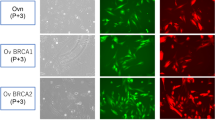Abstract
Cell lines (COLO 320 DM and COLO 320 HSR), established from a human neuroendocrine tumor, contain an amplified cellular oncogene (c-myc). We have previously shown that the homogeneously staining regions (HSRs) of a marker chromosome in the COLO 320 HSR cells that evolved in culture from COLO 320 DM cells contain amplified c-myc. Molecular hybridization in situ has now been used to demonstrate that the HSRs are on both arms of what was once an X chromosome. We also show that amplified c-myc copies are present in the isolated double minute chromosomes (DMs) of the COLO 320 DM cells that were characteristic of the tumor cells initially established from the patient. The results suggest that the amplified c-myc appeared first as DMs and was subsequently transposed to engender HSRs on an X chromosome. The initial COLO 320 tumor cell may have acquired two “early replicating” (i.e., active) X chromosomes and lost the “late replicating” (i.e., inactive) X.
Similar content being viewed by others
References
Alitalo K, Schwab M, Lin CC, Varmus HE, Bishop JM (1983) Homogeneously staining chromosomal regions contain amplified copies of an abundantly expressed cellular oncogene (c-myc) in malignant neuroendocrine cells from a human colon carcinoma. Proc Natl Acad Sci USA 80:1701–1711
Biederman B, Lin CC (1979) R-banding methods for chromosome identification using acridine orange following heat denaturation (RFA) and bromodeoxyurine labeling (RBA). Am Tissue Culture Assoc Manual 5:1189–1192
Blumenthal AB, Dieden JD, Kapp LN, Sedat JW (1979) Rapid isolation of metaphase chromosomes containing high molecular weight DNA. J Cell Biol 81:255–259
Dalla Favera R, Wong-Staal F, Gallo RC (1982) One gene amplification in promyelocytic leukemia cell line HL-60 and primary leukemic cells of the same patient. Nature 299:61–63
Dutrillaux B, Laurent C, Couturiers J, LeJeune J (1973) Coloration par l'acridine orange de chromosomes preablement traites par le 5-bromodeoxyuridine (BrdU). CR Acad Sci Ser D 1276:3179–3181
George DL, Powers VE (1981) Cloning of DNA from double minutes of Y1 mouse adrenocortical tumor cells: Evidence of gene amplification. Cell 24:117–123
Harper ME, Saunders GF (1981) Localization of single copy DNA sequences on G-banded human chromosomes by in situ hybridization. Chromosoma 83:431–439
Levan G, Levan A (1982) Transitions of double minutes into homogeneously staining regions and C-bandless chromosomes in the SEWA tumor. In: Schimke RT (ed) Gene amplification, Cold Spring Laboratory, pp 91–97
Levan G, Mitelman F (1979) Absence of late-replicating X chromosome in a female patient with acute myeloid leukemia and the 8∶21 translocation. J Natl Cancer Inst 62:273–275
Lin CC, Van de Sande H, Smink WK, Newton DR (1975) Quinacrine fluorescence and Q-banding pattern of human chromosomes. I. Effects of varying factors. Can J Genet Cytol 17:81–92
Neel BG, Jhanwar SC, Chaganti RSK, Hayward WS (1982) Two human c-onc genes are located on the long arm of chromosome 8. Proc Natl Acad Sci USA 79:7842–7846
Quinn LA, Moore GE, Morgan RT, Woods LK (1979) Cell lines from human colon carcinoma with unusual cell products, double minutes, and homogeneously staining regions. Cancer Res 39:4914–4924
Schmid W (1965) Autoradiography of human chromosomes. In: Yunis JJ (ed) Human chromosome methodology, Academic Press, New York, pp 102–106
Taub R, Kirsch I, Mortin C, Lenoir G, Swan D, Tronick S, Aaronson S, Leder P (1982) Translocation of c-myc gene into the immunoglobulin heavy chain locus in human Burkitt lymphoma and murine plasmacytoma cells. Proc Natl Acad Sci USA 79:7837–7841
Van Dyke DL, Abraham JP, Maeda K, Weiss L, Poel M (1981) Multiple active X chromosomes in myelofibrosis with myeloid metaplasia. Cancer Genet Cytogenet 3:137–144
Wang HC, Fedoroff PS (1972) Banding in human chromosomes treated with trypsin. Nature New Biol 235:52–54
Yang TP, Hansen SK, Oishi KK, Ryder OA, Hamkalo BA (1982) Characterization of a cloned repetitive DNA sequence concentrated on the human X chromsome. Proc Natl Acad Sci USA 79:6593–6597
Author information
Authors and Affiliations
Rights and permissions
About this article
Cite this article
Lin, C.C., Alitalo, K., Schwab, M. et al. Evolution of karyotypic abnormalities and C-MYC oncogene amplification in human colonic carcinoma cell lines. Chromosoma 92, 11–15 (1985). https://doi.org/10.1007/BF00327240
Received:
Issue Date:
DOI: https://doi.org/10.1007/BF00327240




